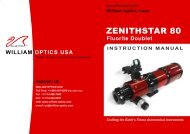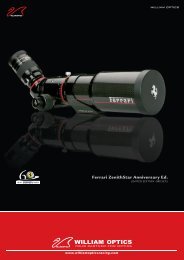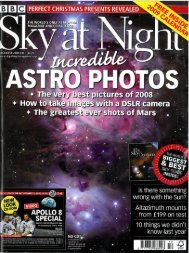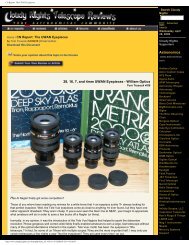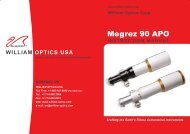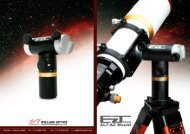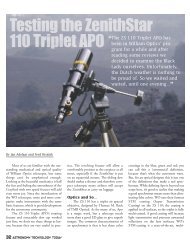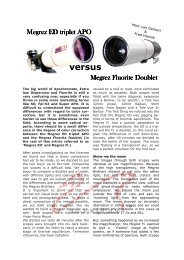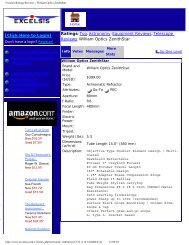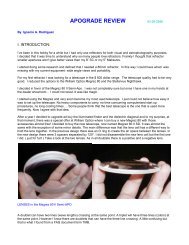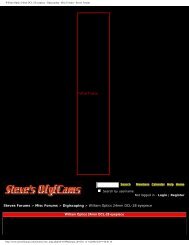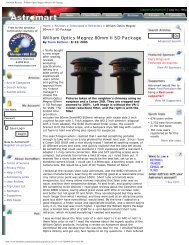Telescope Reviews: William Optics 7x50 ED binocular minireview
Telescope Reviews: William Optics 7x50 ED binocular minireview
Telescope Reviews: William Optics 7x50 ED binocular minireview
- No tags were found...
You also want an ePaper? Increase the reach of your titles
YUMPU automatically turns print PDFs into web optimized ePapers that Google loves.
<strong>Telescope</strong> <strong>Reviews</strong>: <strong>William</strong> <strong>Optics</strong> <strong>7x50</strong> <strong>ED</strong> <strong>binocular</strong> <strong>minireview</strong>really look for it. Surprisingly, I see the least CA slightly off-axis ratherthan directly on-axis.Brightly colored stars are quite vibrant, and night sky contrast is betterthan other 10x50s I've had (Ultima, Nikon Lookout, Olympus EXP 1, OrionUltraview, Swift Sea Wolf).Birds against extreme contrast backgrounds also show little or no CA.Using a RAF chart, the <strong>ED</strong> matched the Nikon 10x42 SE in resolution. Butwhat sets this <strong>binocular</strong> apart from the SE and other non-<strong>ED</strong> bins is itsgreater color saturation.With the Nikon SE, I can see remarkable detail, however, the SE revealsonly a few subtle COLOR variations in a male Cardinal's bird feathers(which other than the wings appears solid red at first glance). The 10x50<strong>ED</strong> shows a wide range of color variation and some subtle colored detailsnot visible with the SE.Yesterday, I spotted two cedar waxwing families, who have taken upwinter residence in my backyard "wildlife habitat" . I watched them forabout a half hour with my 8x32 SE, Swift 8.5X44 Audubon, and 10x50 <strong>ED</strong>.All three bins are very close in resolution, despite their different powersand objective sizes. The colors looked somewhat "flat" in the first two bins(more contrast with the SE) whereas the red wing tips and yellow-tippedtail feathers popped out with the <strong>ED</strong> <strong>binocular</strong>s and showed subtlevariations in color.Given that COLOR variation is a key field mark identifier for birdwatchers,particularly when trying to discern different species in the same genus, I'msurprised there are so few <strong>ED</strong> <strong>binocular</strong>s made.Cost is obviously NOT the reason since Celestron and Eagle <strong>Optics</strong> pricedtheir <strong>ED</strong> bins between $300 and $400, and now WO has a <strong>ED</strong> bin for under$300.I agree with Brock about the Eagle <strong>Optics</strong> 10x50 <strong>ED</strong> showing more colorsaturation than all the Nikon SE's,that would be 8,10 and 12 SE.We wereusing the Edmund's USAF Resolving Power Chart and this chart has red,green,yellow,blue and black USAF targets in a x shape.I really was kind ofsurprised to say the least and WOULD NOT BELIEVE IT IF I DIDN'T SEE ITWITH MY OWN EYES.Steve MPost Extras:http://www.cloudynights.com/ubbthreads/showflat.php/Cat/0...mber/694293/page/0/view/collapsed/sb/5/o/all/fpart/1/vc/1 (13 of 22)2006/4/26 •• 04:44:56



